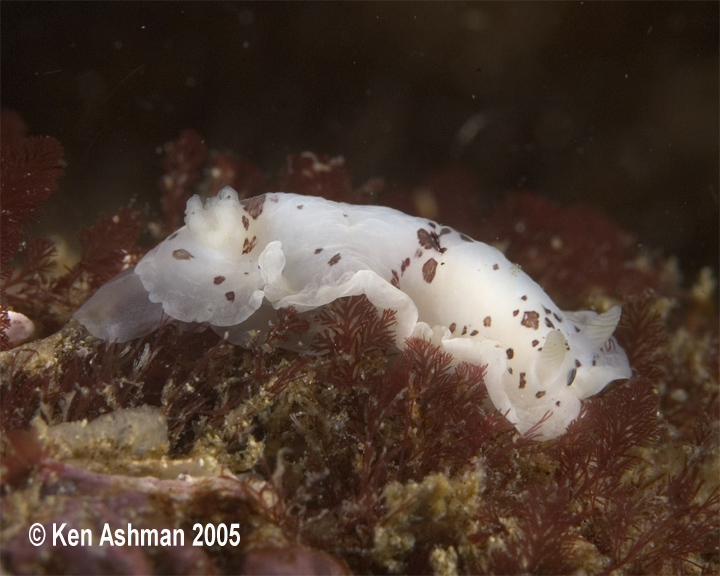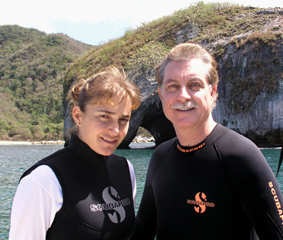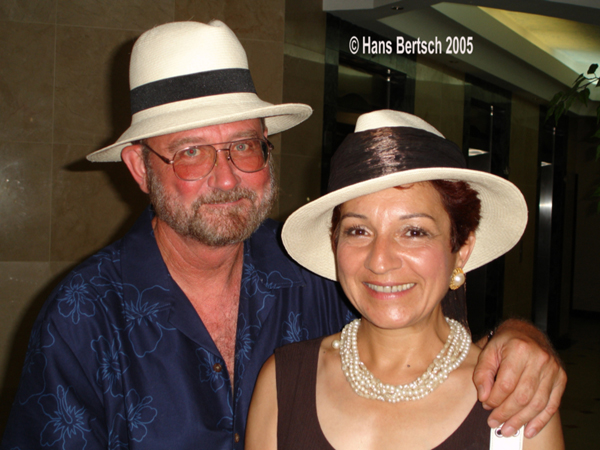 |
Dendrodoris behrensi
Photo courtesy of Ken Ashmanof California Digital Diving
Ali Hermosillo and Dave Behrens Although Sandra Millen and I just named
this species 26 August 2005, it has been collected and
observed for many years. Even Frank Mace MacFarland collected specimens at the large tide
pool in Pacific Grove, California, in 1921 and 1929. In
our article we document numerous sites of its occurrence between
Point Pinos, Monterey Bay, California (approximately 37°27' N; 121°55' W), to the
San Benito
Islands , Baja
California, Mexico (approximately 28°18' N; 115°34' W). The slender, elongate body has a narrow mantle margin, and can reach a length of 20 mm.
The smooth dorsum lacks tubercles or spines. The
straight rhinophores have 7-13 sloping lamella. There are 3-6
bipinnate (or weakly tripinnate) gills arranged in a circlet. It is clearly distinguished by its variable
external coloration . “The ground color is semi-translucent white or pale
cream. There are round dark reddish brown or chocolate brown spots on the notum but not
the
mantle rim . These vary in
size, but the larger spots tend to be clustered in four areas in the midline. These are in front of
the rhinophores, behind the rhinophores, the middle of the body and in front of the gills.
Sometimes the anterior-most cluster is absent. Smaller spots are scattered towards the edges of
the dorsum. Rhinophores and gills are white or cream” (from Sandra's and my description of the
species). Color photographs of this species appeared in Behrens, 1980: fig. 141 (as Dendrodoris
sp.), Behrens, 1991: fig. 132 (as Dendrodoris sp. 3), and in McDonald & Nybakken, 1980: fig.
58 (as Dendrodoris species b). Of course, it is shown in Behrens & Hermosillo (2005: fig. 178) as Dendrodoris behrensi. In the text of our manuscript, we also describe the internal anatomy: digestive system (of
course, being a porostome, there is no radula), the heart, and the nervous and reproductive
systems. Immediately following our article in Proceedings of the California Academy of Sciences,
where we name Dendrodoris behrensi as a new species, there is an excellent article by Jeffrey H.
R. Goddard describing the direct development of this species. He includes microscopic
photographs of the blastula (4 days after oviposition), embryonic veligers (day 24), and the
hatching juvenile (day 38) and a juvenile 4 days after hatching. I hope that this BOW, and Sandra's and my naming the species Dendrodoris behrensi,
serve as a partial tribute to honor Dave for his “nudibranchology” and friendship. LITERATURE CITED Behrens, David W., and Alicia Hermosillo. 2005. Eastern Pacific Nudibranchs: A Guide to the Opisthobranchs from Alaska to Central America. Sea Challengers, Monterey, CA. vi + 137 pp.
Behrens, David W. 1980. Pacific coast nudibranchs. A guide to the opisthobranchs of the
northeastern Pacific. Sea Challengers. Los Osos, CA. 112 pp. -----. 1991. Pacific coast nudibranchs. A guide to the opisthobranchs, Alaska to Baja California.
Sea Challengers, Monterey, CA. vi + 107 pp. Goddard, Jeffrey H. R. 2005. Ametamorphic direct development in Dendrodoris behrensi
(Nudibranchia: Dendrodorididae), with a review of developmental mode in the family.
Proceedings of the California Academy of Sciences (4th Series) 56 (19): 201-211. McDonald, Gary R., and James W. Nybakken. 1980. Guide to the nudibranchs of California,
including most species found from Alaska to Oregon. American Malacologists, Inc.,
Melbourne, Florida. 72 pp. Millen, Sandra V., and Hans Bertsch. 2005. Two new species of porostome nudibranchs
(Family Dendrodorididae) from the coasts of California (USA) and Baja California
(Mexico). Proceedings of the California Academy of Sciences (4th Series) 59 (18): 189-199.
WEBMASTER'S NOTES : Hans is a hard act to follow, but here we go. Last Month the Slug Site celebrated its tenth anniversary, an event
that never would have happened without Dave's unwavering support of the site through the years. Dave literally lives and breathes branching as I do, our respective spouses will certainly vouch for that!
In many respects, Dave personifies the "energizer" bunny in all those TV ads, he always seems to have energy for that one last project! If I had a hat like Hans below, it certainly would be off to Dave for his many accomplishments in nudibranchology!
Send Hans email at hansmarvida@sbcglobal.net

Dendrodoris behrensi Millen & Bertsch, 2005
It is a very special honor to write this Nudibranch of the Week about a species named for
David W. Behrens, good friend, colleague, and nudibranch expert, who is well known to all the readers of this web site. I am especially
grateful to him for not only his advancements in the field of opisthobranch study, but also for the
cordiality and generousness with which he shares his knowledge either personally or on a wider
scale through his numerous publications, both in print and on the internet.
Imperial Beach, California
Dec., 2005
Merry Xmas and a Happy New Year!
Webmaster
San Diego, Calif
Dec. 2005
All attended the VI meeting of the Congreso Latinoamericano de Malacologia.

